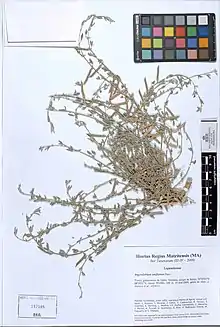Argyrolobium uniflorum
Argyrolobium uniflorum is a wild pluriannual herbaceous species of drought tolerant legume found in arid regions of Northern Africa[2] sometimes described as pseudo-savannah.[3] A. uniflorum is a hardy wild species of plant and it is considered a valuable forage crop for agriculture in Africa.[4] It is also useful as a potentially important species in bioremediation and dryland restoration in arid regions of Tusinia which are sensitive to misappropriation and overgrazing.[4]
| Argyrolobium uniflorum | |
|---|---|
 | |
| Scientific classification | |
| Kingdom: | Plantae |
| Clade: | Tracheophytes |
| Clade: | Angiosperms |
| Clade: | Eudicots |
| Clade: | Rosids |
| Order: | Fabales |
| Family: | Fabaceae |
| Subfamily: | Faboideae |
| Genus: | Argyrolobium |
| Species: | A. uniflorum |
| Binomial name | |
| Argyrolobium uniflorum | |
| Synonyms[1] | |
|
Cytisus uniflorus Decne. | |
Morphology
Argyrolobium uniflorum has been described as a dwarf flowering shrub with stems 10-18 inches long, with infolded leaflets, solitary flowers opposite the leaf.[5]
Distribution
Argyrolobium uniflorum is found in South Africa along the Berg River and on the Vanstaadensberg mountain range and uncommonly in Albany Africa.[5] Recent examples of the species in Europe in South Eastern Spain and are considered an emerging plant in these areas.[6]
Symbiosis
Argyrolobium uniflorum is a symbiosis competent legume. It is capable of nodule formation[7] and nitrogen fixing symbiosis with species of alphaproteobacteria.[4][2]
References
- "Argyrolobium uniflorum (Decne.) Jaub. & Spach". Plants of the World Online. The Trustees of the Royal Botanic Gardens, Kew. n.d. Retrieved December 26, 2022.
- Dekak, Ahmed; Chabi, Rabah; Menasria, Taha; Benhizia, Yacine (2018-11-01). "Phenotypic characterization of rhizobia nodulating legumes Genista microcephala and Argyrolobium uniflorum growing under arid conditions". Journal of Advanced Research. 14: 35–42. doi:10.1016/j.jare.2018.06.001. ISSN 2090-1232. PMC 6041434. PMID 30009051.
- "CAB Direct". www.cabdirect.org. Retrieved 2021-09-04.
- Rejili, M.; Mahdhi, M.; Fterich, A.; Dhaoui, S.; Guefrachi, I.; Abdeddayem, R.; Mars, M. (2012-08-15). "Symbiotic nitrogen fixation of wild legumes in Tunisia: Soil fertility dynamics, field nodulation and nodules effectiveness". Agriculture, Ecosystems & Environment. 157: 60–69. doi:10.1016/j.agee.2012.01.015. ISSN 0167-8809.
- "Argyrolobium uniflorum in Global Plants on JSTOR". plants.jstor.org. Retrieved 2021-09-04.
- Alcaraz, F.; De La Torre, A. (1991). "Argyrolobium uniflorum (Leguminosae), a New Species for the European Flora". Willdenowia. 21 (1/2): 69–72. ISSN 0511-9618. JSTOR 3996591.
- Zakhia, Frédéric; Jeder, Habib; Domergue, Odile; Willems, Anne; Cleyet-Marel, Jean-Claude; Gillis, Monique; Dreyfus, Bernard; De Lajudie, Philippe (2004-01-01). "Characterisation of Wild Legume Nodulating Bacteria (LNB) in the Infra-arid Zone of Tunisia". Systematic and Applied Microbiology. 27 (3): 380–395. doi:10.1078/0723-2020-00273. ISSN 0723-2020. PMID 15214644.